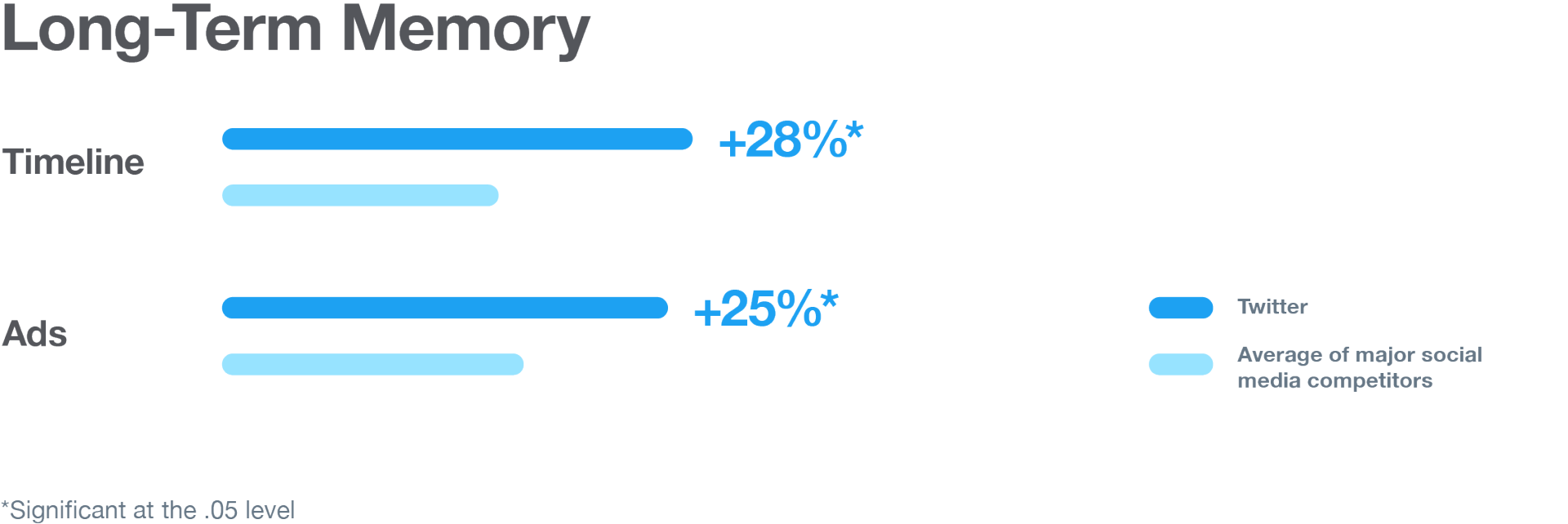Insights
Twitter’s audience is more receptive to ads

A study confirms that people on Twitter are more receptive to content than people on other social platforms.
Twitter’s audience is unique in many ways. For starters, when most people open Twitter, they’re looking for something new. In fact, December 2017 research confirmed that 79% of Twitter users say they learn something new and valuable on Twitter weekly.1
Unlike on other social platforms, our audience generally doesn’t come to Twitter to share vacation photos or recipes. Rather, they come to find and Retweet the latest sports scores, news stories, must-have products, and more. If posts on other social platforms say “look at me,” posts on Twitter say “look at this.”
Because our audience is so curious and engaged, they’re also more receptive to new content, including messages from brands. Receptivity is one of the core pillars of what makes our audience so valuable, and we sought to better understand how this trait could be measured and compared to other social platforms. To that end, Twitter partnered with Omnicom Media Group and Neuro-Insight and used advanced brain imaging technology to see how content consumption on various social media platforms differs neurologically.
Using three key metrics — emotional intensity, memorability, and time watched — we set out to quantify the ways that people on Twitter are more receptive to content than people on other social media platforms.
Emotional intensity
We found that people on Twitter are more likely to have a stronger emotional reaction to what they’re seeing on Twitter, especially when they see ads. Compared to people on three major competitor social platforms, Twitter’s audience is more energized, captivated, and engrossed by the content on their timeline. The data may suggest that instead of passively scrolling, people on Twitter are more likely to connect with what they are seeing on an emotional level.

Memorability
Over the long term,2 we found that people on Twitter are more likely to remember what they’ve seen on our platform versus our competitors. What you say to people on Twitter interests them in the moment and sticks with them after they leave.

Why are emotional intensity and memorability so important? Because these neurological measures have been directly linked to the success of an ad at driving market performance. In a separate 2011 study, Thinkbox found that ads that had stronger brain response, particularly emotional intensity and right brain memory encoding, see higher impact on market performance.3 This higher-level brain activity supports the view that ads that succeed emotionally tend to also drive market performance.
Time spent watching ads
Lastly, we found that people spend more time watching an ad on Twitter than they do watching an ad on two major competitor social platforms,4 because people on Twitter are more likely to stop scrolling and watch your video.

Even the most ingenious ads won’t work if the audience viewing them isn’t receptive. That’s why brands turn to Twitter to make a lasting impression. As our audience reads, reacts, and Retweets, their brains are in a naturally more receptive state. With their emotions heightened and their passions engaged, they’re more likely to remember what they’ve seen.
To get a great reception for your brand, you need a receptive audience. When planning your next campaign, start with the people on Twitter.
Methodology
Source: Twitter-commissioned study: Neuro-Insight, OMG, Twitter Receptivity, October 2018, United States
Respondents were recruited and convened in focus groups as they would be for conventional research. Respondents were active users (at least once a week) of the platform that they used in testing. Once respondents arrived on the test site they were given a short introduction to the process and experience. Specific details regarding the cap, visors, and other items are explained to ensure full participation. Respondents then were fitted with the headsets, which incorporate a visor through which they view material. Neuro-Insight staff checks caps prior to screening content to ensure there is a strong signal coming from each cap. Once all headsets and data have been checked, we commence with the browsing experiences. We record the brain data during this period and all data is passively recorded, no questions are asked. We also video record how the respondents are interacting on their mobile devices. Participants used their own mobile phones to browse each platform and ads were analyzed as they would naturally occur.
Footnotes:
1. Twitter-commissioned study: Kantar News, Discovery & Influence on Twitter; December 2017; USA; 787 Monthly Twitter USA users & 1503 Online USA population
2. “Long term” means effectively anything that is stored in the brain to be recalled more than a few minutes later. This measure is recorded for both the left brain (detail) and right brain (emotional or holistic memory).
3. Neuro-Insight (2011). Payback 3. Thinkbox. London. (While this study measured the neurological effectiveness of TV ads and not digital ads, the links between brain activity and consumer behavior remain consistent when ads are served digitally.)
4. Facebook and Instagram